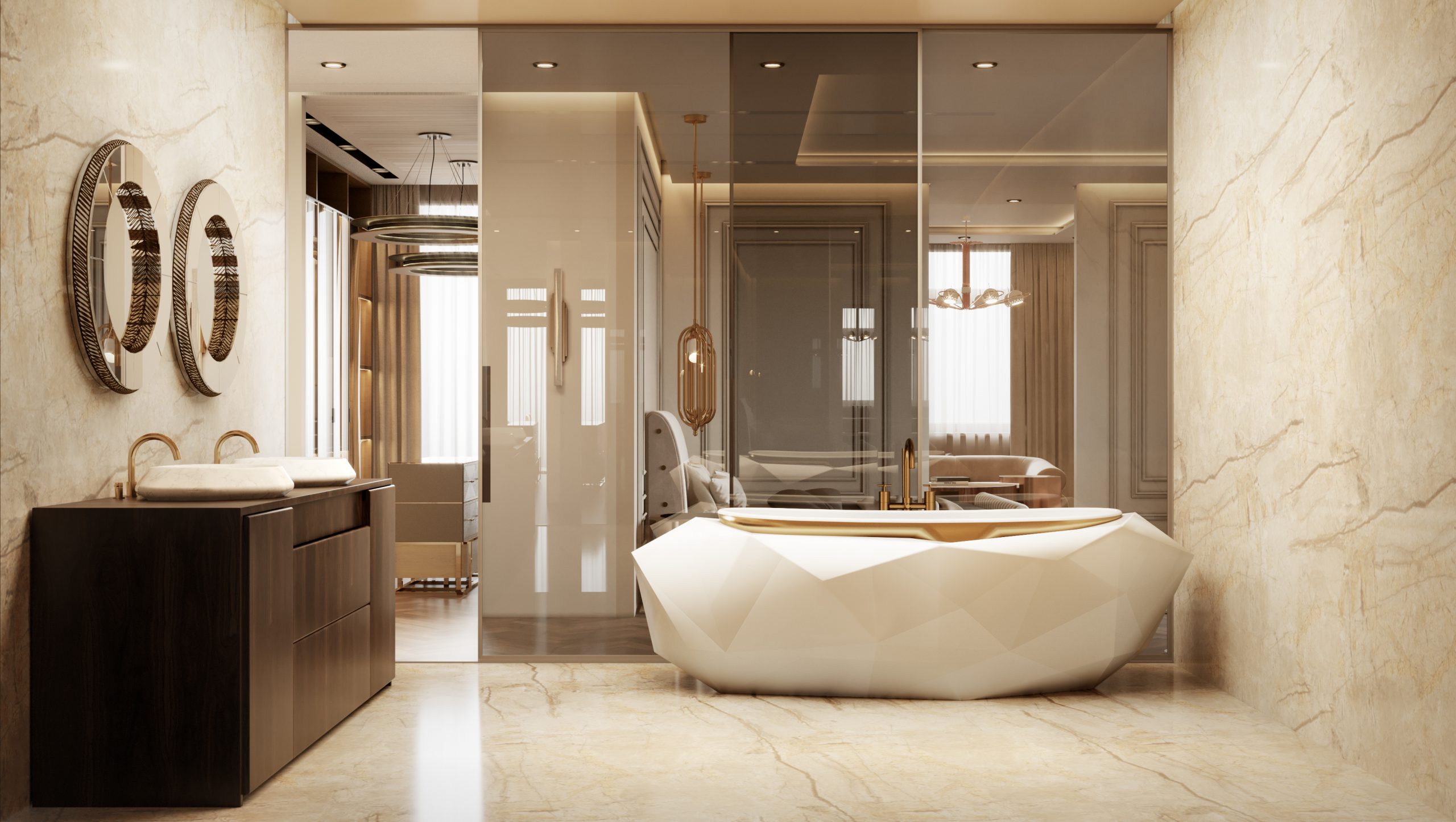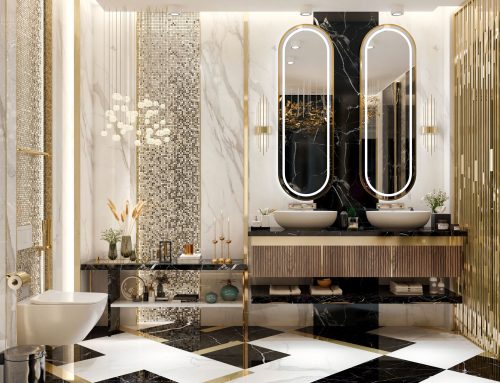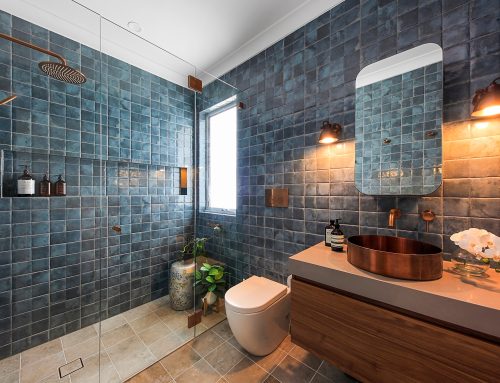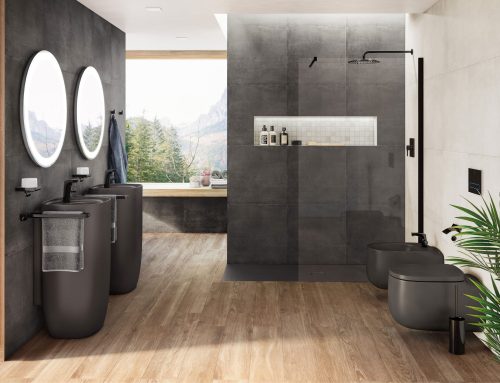Bathrooms have evolved from mere utilitarian spaces to luxurious retreats that reflect personal style and comfort. Whether you are planning a complete remodel or a simple update, understanding the latest trends can help you create a space that is both functional and stylish. This guide covers ten of the most popular topics in bathroom design and remodeling, providing insights and inspiration for your next project.
1. Spa-Like Retreats: Transforming Your Bathroom into a Sanctuary
In today’s fast-paced world, more homeowners are seeking to transform their bathrooms into spa-like retreats where they can relax and unwind. Creating a luxurious, serene atmosphere involves several key elements:
Soaking Tubs and Freestanding Bathtubs: Soaking tubs, particularly freestanding models, have become a hallmark of luxury bathrooms. These tubs not only serve as a focal point but also offer a deep, immersive bathing experience. Popular materials include acrylic, stone resin, and cast iron, each offering different aesthetic and tactile qualities.
Rain Showers and Steam Rooms: Rain showers replicate the sensation of standing in a gentle rain, providing a soothing experience. Pairing rain showerheads with steam rooms enhances the spa experience, offering therapeutic benefits such as improved circulation and relaxation. Advanced systems allow for customization of water temperature, pressure, and even aromatherapy options.
Ambient Lighting: Lighting plays a crucial role in creating a spa-like ambiance. Soft, dimmable lights, strategically placed around the bathroom, can mimic the tranquil atmosphere of a high-end spa. Incorporating LED strips under vanities, around mirrors, and in showers adds a subtle, relaxing glow.

2. Sustainable and Eco-Friendly Designs: Going Green in the Bathroom
As awareness of environmental issues grows, many homeowners are opting for sustainable and eco-friendly bathroom designs. This trend involves the use of environmentally friendly materials, water-saving fixtures, and energy-efficient lighting.
Eco-Friendly Materials: Sustainable materials such as bamboo, recycled glass, and reclaimed wood are increasingly popular. These materials not only reduce environmental impact but also add unique textures and colors to the bathroom. For example, bamboo is a fast-growing, renewable resource that can be used for flooring, cabinetry, and accessories.
Water-Saving Fixtures: Water conservation is a key aspect of eco-friendly bathroom design. Low-flow toilets, faucets, and showerheads can significantly reduce water usage without compromising performance. Dual-flush toilets, which offer separate flush options for liquid and solid waste, are particularly effective in conserving water.
Energy-Efficient Lighting: LED lighting is an essential component of sustainable bathroom design. LEDs consume significantly less energy than traditional incandescent bulbs and have a much longer lifespan. Additionally, installing motion sensors or timers can further enhance energy efficiency by ensuring lights are only on when needed.
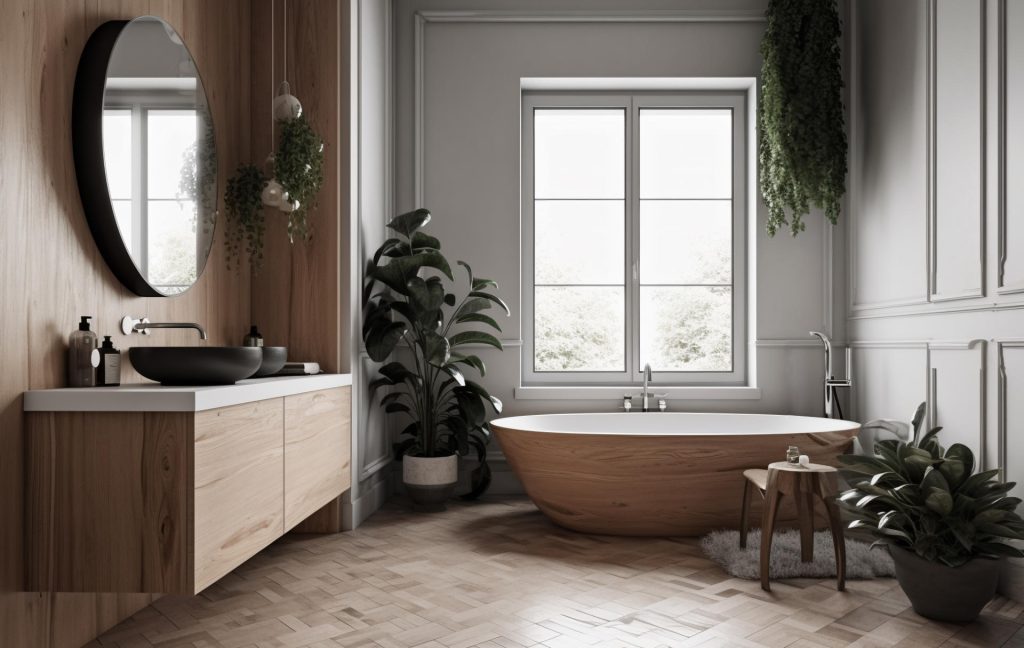
3. Smart Technology Integration: The Future of Bathroom Design
The integration of smart technology into bathroom design is revolutionizing how we use and interact with these spaces. From smart mirrors to touchless faucets, modern bathrooms are becoming more convenient and personalized.
Smart Mirrors: Smart mirrors, equipped with features such as built-in lighting, anti-fog capabilities, and Bluetooth connectivity, are becoming a staple in contemporary bathrooms. Some models even offer touchscreens that provide weather updates, news, and other useful information, making your morning routine more efficient.
Touchless Faucets and Toilets: Touchless technology, originally popular in commercial settings, is now making its way into residential bathrooms. Touchless faucets and toilets use sensors to activate water flow or flushing, reducing the spread of germs and improving hygiene. Additionally, these fixtures often come with water-saving features.
Automated Lighting and Sound Systems: Automated lighting systems allow you to control the brightness and color of your bathroom lights with a smartphone app or voice commands. Integrating a sound system can further enhance the experience, allowing you to play your favorite music or listen to podcasts while getting ready.
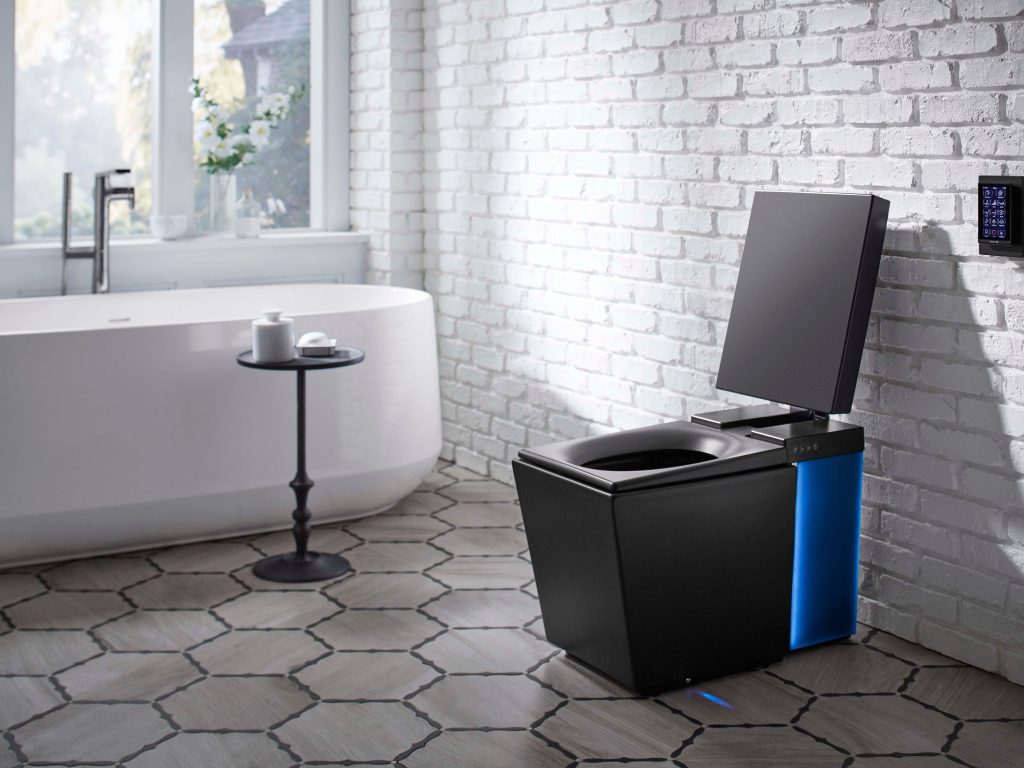
4. Modern Minimalism: Embracing Simplicity and Functionality
Modern minimalism is characterized by clean lines, simple color schemes, and uncluttered spaces. This design approach emphasizes functionality and avoids unnecessary ornamentation.
Clean Lines and Geometric Shapes: Minimalist bathrooms often feature clean, straight lines and geometric shapes. This can be seen in the design of vanities, mirrors, and fixtures. The goal is to create a sleek, streamlined look that feels calm and orderly.
Monochromatic Color Schemes: A monochromatic color scheme, typically in shades of white, gray, or black, enhances the minimalist aesthetic. These colors create a sense of spaciousness and serenity. Accents can be added through natural materials or subtle textures.
Functional Storage Solutions: Clutter can quickly disrupt the minimalist aesthetic, so effective storage solutions are essential. Floating vanities, built-in shelving, and hidden compartments help keep the bathroom organized and maintain a clean appearance.
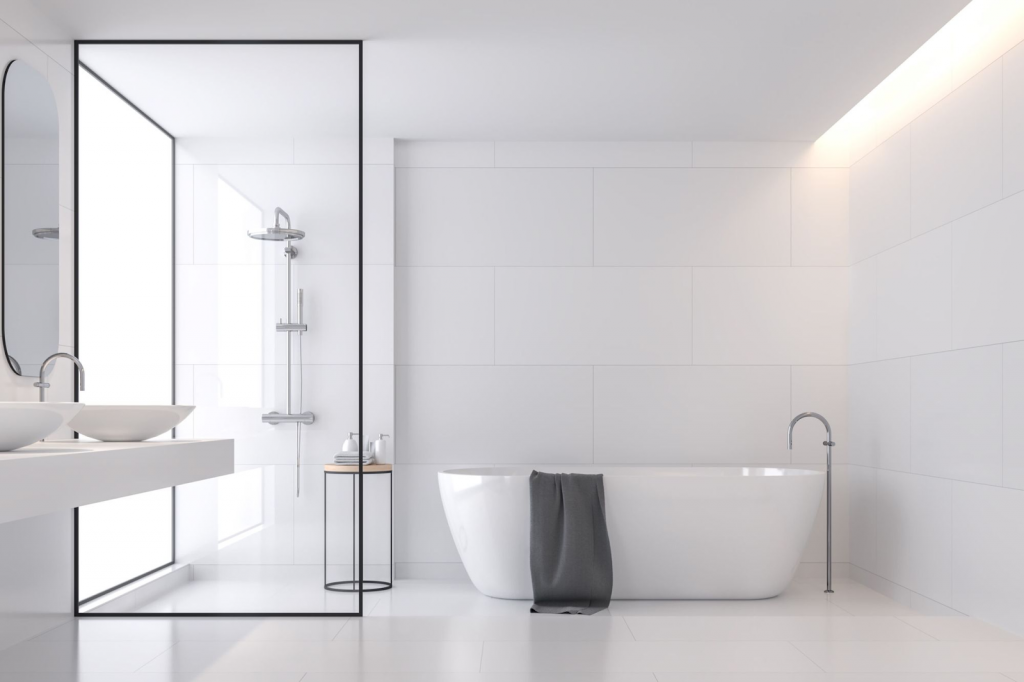
5. Vintage and Retro Styles: A Nostalgic Nod to the Past
Vintage and retro bathroom designs bring a touch of nostalgia and charm to modern homes. By incorporating classic fixtures, clawfoot tubs, and vintage tile patterns, you can create a bathroom that feels timeless and unique.
Classic Fixtures and Hardware: Vintage bathrooms often feature fixtures with traditional designs, such as pedestal sinks, cross-handle faucets, and exposed plumbing. Brass, bronze, and chrome finishes add to the nostalgic feel. Vintage-inspired lighting fixtures, like sconces and chandeliers, complete the look.
Clawfoot Tubs: Clawfoot tubs are a quintessential element of vintage bathroom design. These freestanding tubs, often made of cast iron and finished with enamel, provide a luxurious bathing experience and serve as a striking focal point.
Retro Tile Patterns: Tile plays a significant role in vintage and retro bathrooms. Classic patterns like subway tiles, hexagonal mosaics, and checkerboards bring a historic touch. Colors can range from timeless black and white to more playful pastel hues.
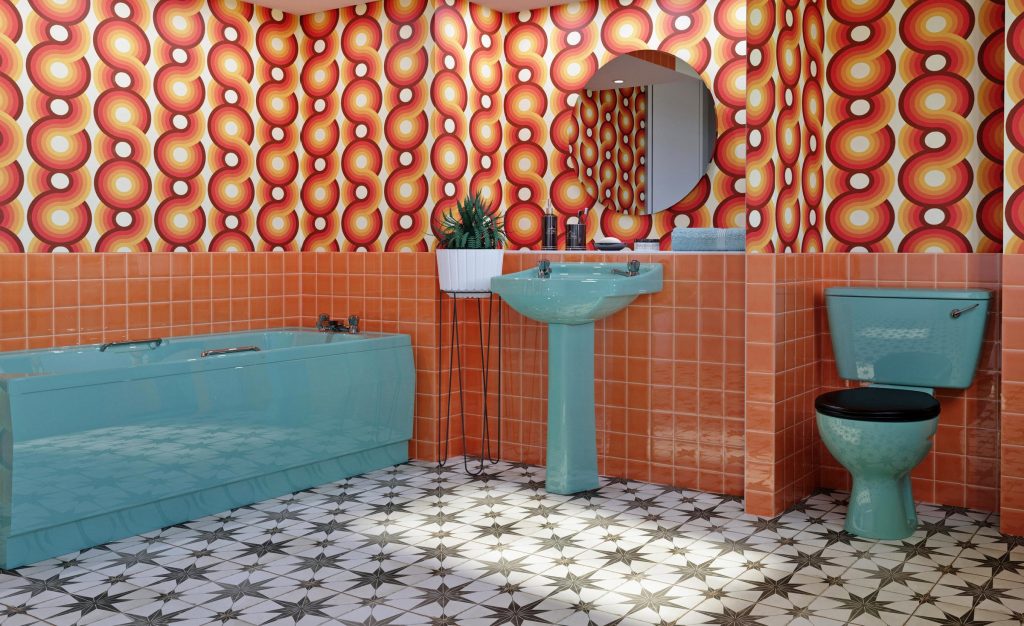
6. Natural Elements: Bringing the Outdoors In
Incorporating natural elements into bathroom design creates a calming, organic atmosphere. This trend focuses on the use of natural materials like wood, stone, and plants.
Wood Accents: Wooden elements add warmth and texture to the bathroom. Options include wooden vanities, shelving, and even accent walls. To ensure durability in a humid environment, it’s important to choose moisture-resistant finishes and types of wood, such as teak or cedar.
Stone Surfaces: Natural stone, such as marble, granite, and travertine, is a popular choice for countertops, flooring, and shower surrounds. Stone adds a sense of luxury and permanence to the bathroom. Each piece of stone has unique veining and patterns, making every installation one-of-a-kind.
Indoor Plants: Adding plants to the bathroom can improve air quality and enhance the overall aesthetic. Plants like ferns, orchids, and peace lilies thrive in the humidity of a bathroom environment. They can be placed on countertops, hung from the ceiling, or positioned in corners to create a lush, green oasis.
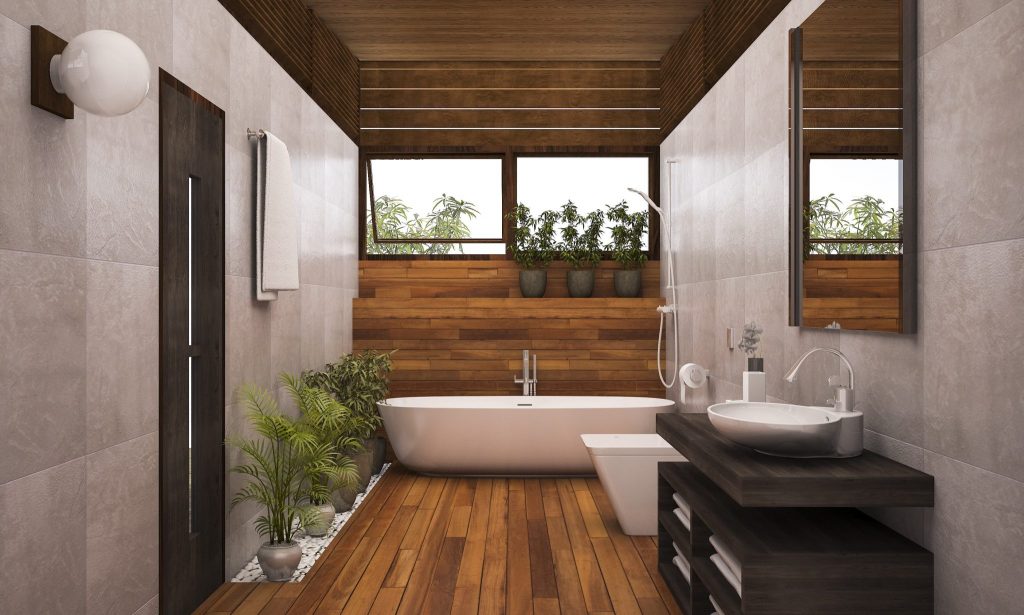
7. Bold and Dark Color Schemes: Making a Dramatic Statement
While white and neutral tones have long been staples of bathroom design, bold and dark color schemes are gaining popularity. These colors create a dramatic, sophisticated look.
Deep Hues: Colors like navy, charcoal, emerald, and burgundy add depth and drama to the bathroom. These hues can be used on walls, cabinetry, or even tiles. When balanced with lighter elements, such as white fixtures or metallic accents, they create a striking contrast.
Black Fixtures: Black fixtures and hardware are a key trend in modern bathrooms. Black faucets, showerheads, and towel bars offer a sleek, contemporary look that pairs well with both bold and neutral color schemes. Matte black finishes are particularly popular for their understated elegance.
Accents and Accessories: To enhance a bold color scheme, consider using metallic accents like gold, brass, or copper. These finishes add a touch of glamour and sophistication. Additionally, incorporating patterned tiles or wallpapers can introduce texture and visual interest.

8. Space-Saving Solutions: Maximizing Small Bathrooms
Designing for small bathrooms requires creativity and smart solutions to maximize space without sacrificing style. Space-saving strategies include innovative storage solutions, compact fixtures, and multifunctional elements.
Floating Vanities: Floating vanities create the illusion of more space by elevating cabinetry off the floor. This design not only provides storage but also opens up the floor area, making the bathroom feel larger. For added functionality, consider vanities with integrated drawers and shelves.
Compact Fixtures: Choosing compact fixtures is essential for small bathroom design. Wall-mounted toilets, narrow sinks, and corner showers are excellent options that save space while maintaining functionality.

9.Luxury Tiles and Finishes: Using High-End Materials to Add Elegance and Style
Luxury tiles and finishes can transform an ordinary bathroom into a space of elegance and sophistication. High-end materials such as marble, mosaic tiles, and custom finishes elevate the design, making the bathroom not just a functional space but a statement of personal style and taste.
Marble: Timeless Elegance and Natural Beauty
Marble has long been associated with luxury and opulence. Its natural beauty, characterized by unique veining and patterns, makes it a preferred choice for many high-end bathrooms. Here’s how to incorporate marble into your bathroom design:
Marble Countertops and Vanities: Marble countertops provide a stunning surface for vanities. Their smooth, cool surface is perfect for bathrooms, adding a touch of luxury. Custom marble vanities can be tailored to fit your space and style preferences, often featuring intricate edge profiles and integrated sinks.
Marble Flooring: Marble flooring creates an immediate sense of elegance. Available in various colors and patterns, it can complement any design scheme. For added safety, opt for honed or textured marble to reduce the risk of slipping.
Marble Shower Walls: Covering shower walls in marble tiles or slabs turns a simple shower into a spa-like retreat. The natural veining of marble adds a dramatic effect, and when paired with glass enclosures, it becomes the focal point of the bathroom.
Mosaic Tiles: Artistic Expression and Intricate Detail
Mosaic tiles are a versatile and artistic choice for bathrooms. They come in various materials, including glass, ceramic, and stone, and can be used to create intricate patterns and designs.
Accent Walls and Backsplashes: Mosaic tiles are perfect for creating eye-catching accent walls and backsplashes. Whether you choose a classic pattern like herringbone or a custom design, mosaic tiles add texture and color, making these areas stand out.
Shower Niches and Inlays: Using mosaic tiles in shower niches and as inlays within larger tiles can add subtle detail and visual interest. This approach allows you to introduce color and pattern without overwhelming the space.
Floor Medallions and Borders: Incorporate mosaic tiles as floor medallions or borders to add an artistic touch to your bathroom flooring. These detailed designs can highlight certain areas, such as the space around a freestanding tub or the entrance to the shower.
Custom Finishes: Personalization and Unique Touches
Custom finishes offer an opportunity to personalize your bathroom and create unique, one-of-a-kind elements.
Hand-Painted Tiles: Hand-painted tiles can be used as accents or in larger installations to create a bespoke look. These tiles can feature anything from traditional patterns to modern art, providing a unique focal point.
Bespoke Vanities and Cabinetry: Custom-built vanities and cabinetry, crafted from high-quality materials like solid wood or exotic veneers, add both functionality and beauty. Custom finishes, such as distressed or high-gloss lacquer, can be tailored to match your design vision.
Artisan Fixtures: Artisan-made fixtures, such as hand-forged faucets, custom mirrors, and bespoke lighting, add an element of craftsmanship and artistry to the bathroom. These pieces often feature unique designs and high-quality finishes that standard fixtures cannot match.
Combining Luxury Elements for a Cohesive Design
To create a cohesive and luxurious bathroom, it’s important to thoughtfully combine these high-end materials and finishes. Here are some tips for achieving a harmonious design:
Coordinate Colors and Textures: When selecting luxury materials, ensure that their colors and textures complement each other. For example, pair the cool tones of marble with the warm hues of brass fixtures, or balance the intricate details of mosaic tiles with the simplicity of a solid marble countertop.
Balance Bold and Subtle Elements: Mix bold, statement-making elements with more subtle features to avoid overwhelming the space. For instance, if you have a dramatic marble shower wall, opt for simpler floor tiles to balance the design.
Focus on Key Areas: Identify the focal points of your bathroom, such as the vanity, shower, or bathtub, and use luxury materials in these areas to draw attention. This approach ensures that the most important elements of your bathroom stand out and make a lasting impression.
Practical Considerations for Luxury Materials
While luxury materials add elegance and style, they also require proper care and maintenance to preserve their beauty.
Maintenance of Marble: Marble is porous and can stain or etch if not properly sealed and maintained. Regular sealing, gentle cleaning with pH-neutral products, and prompt wiping of spills are essential to keep marble looking pristine.
Durability of Mosaic Tiles: Mosaic tiles, particularly those made of glass or ceramic, can be delicate. Ensure proper installation to prevent cracking or chipping, and clean them with mild, non-abrasive cleaners to avoid damaging the surface.
Custom Finish Care: Custom finishes, such as hand-painted tiles or bespoke vanities, may require special care instructions from the manufacturer or artisan. Follow these guidelines to ensure the longevity and appearance of your custom pieces.
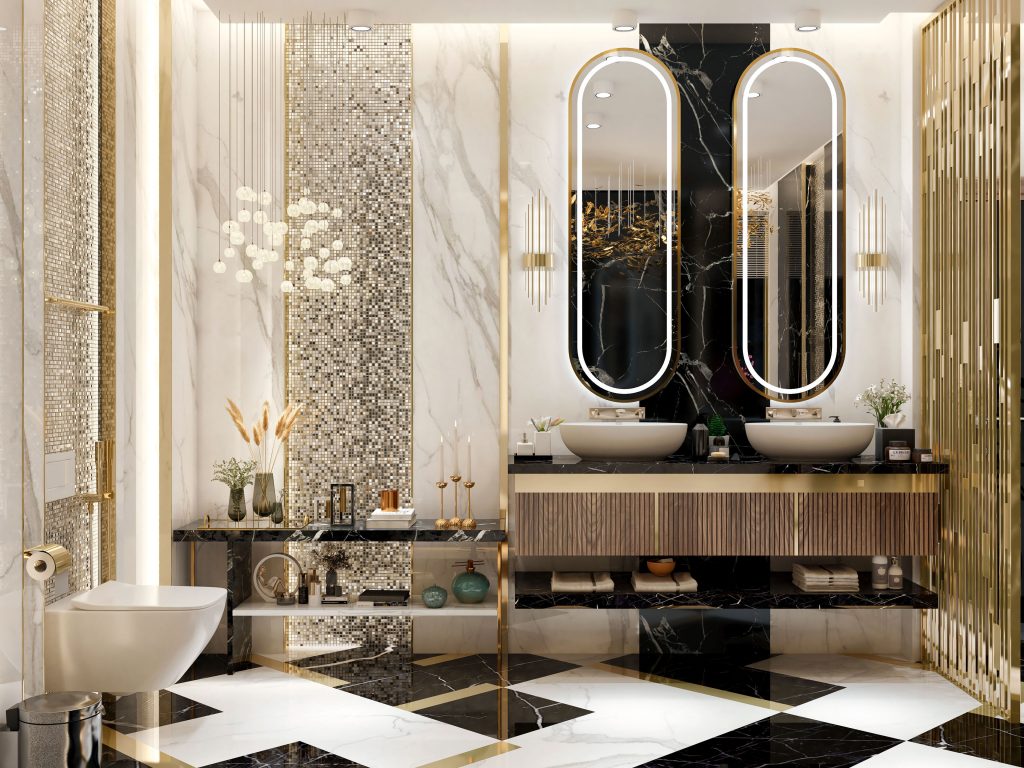
10. Universal Design and Accessibility: Creating Inclusive Bathrooms
Universal design focuses on creating spaces that are accessible and usable by everyone, regardless of age, ability, or mobility. Incorporating universal design principles into your bathroom ensures that it is safe and functional for all users.
Walk-In Showers: Walk-in showers, with no threshold or a low threshold, are a key component of universal design. These showers are accessible for people with mobility issues and can be equipped with features like grab bars, built-in seating, and handheld showerheads to enhance safety and convenience.
Grab Bars and Non-Slip Flooring: Installing grab bars near the toilet, shower, and bathtub provides additional support and stability. Non-slip flooring, such as textured tiles or rubber flooring, reduces the risk of slips and falls, making the bathroom safer for everyone.
Accessible Fixtures: Accessible fixtures, such as comfort-height toilets and vanities, ensure ease of use. Comfort-height toilets are higher than standard toilets, making it easier for people with mobility issues to sit and stand. Vanities with open space underneath can accommodate wheelchair users, providing easier access to the sink.
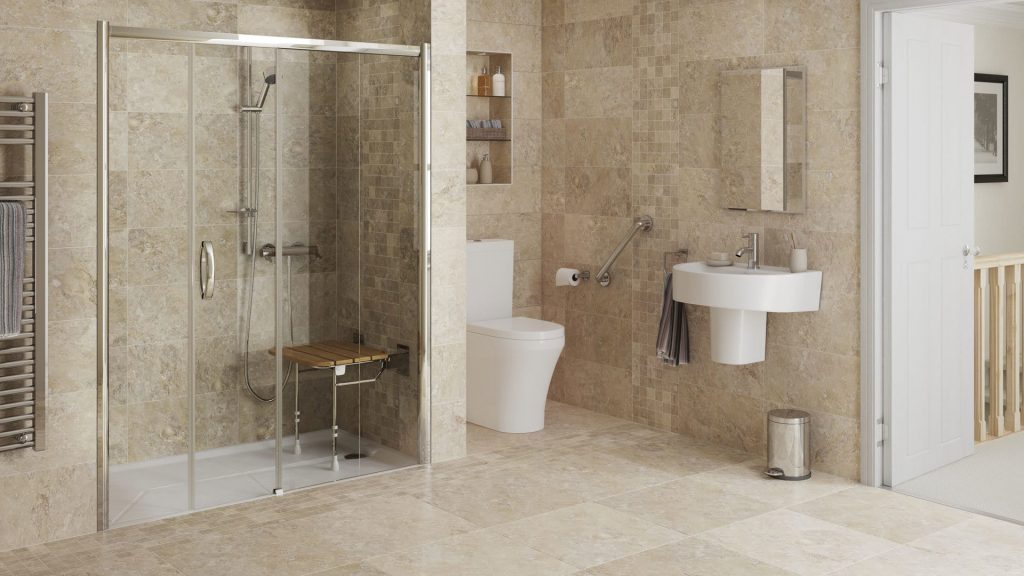
Conclusion
Incorporating these popular trends into your bathroom design ideas or remodeling project can transform the space into a functional, stylish, and comfortable retreat. Whether you are aiming for a spa-like sanctuary, a minimalist haven, or an accessible and inclusive bathroom, understanding and utilizing these trends will help you create a space that meets your needs and reflects your personal style.
By focusing on elements such as sustainable materials, smart technology, natural elements, and luxury finishes, you can elevate the design and functionality of your bathroom. Whether you have a small bathroom that requires space-saving solutions or you want to make a bold statement with dark colors and custom finishes, there are countless ways to personalize your space.
A division of Ross Brothers Construction Click here to see all our completed projects
